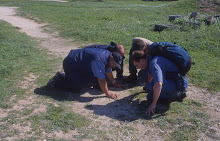In the funny but important paper Putting the plants back into plant ecology: six pragmatic models for understanding and conserving plant diversity" Keddy contrasts two widespread approaches in platn ecologists. He calls the first "theoreticians", that start from principles and deduce complex mathematical models, and the second "pragmatists" that begisn from observations and generalize to borad regularities. The first approach is clearly winning, but ecologists (in particular American ecologists) are well known for their episthemological unsofisticatedness. The contrast of Keddy is the two-thousand year old Aristotelian constrast between deduction and induction, and we know all too well that science is based enither on induction nor on deduction, but on a third process known as "abduction". Curiously, it was an American geologist and philosopher, Pierce, that highlighted the question (that had already been discovered, in other terms, bu Kant at the end of the XVIII century). In abduction, you neither start from principles and end with test, nor begin with observation and arrive to generalization, but you start with observations and ask "which theoretical model can possibly explain the observations?" After the model is build up, you look for confirmation in independent observations. For instance, Schrodinger equation, that describes the properties of electron in quantum mechanics, is not derived from obeservation (it is a wave function in a probability space that cannot be observed) nor from principles (in fact it seems quite crazy), but is the only model that explains observations such as the distribution of spectral lines of hydrogen or the scattering of electrons. In simpler terms, you begin with observation, build the model, and test the consequences of the model, not the model in itself. I have found two or three examples of this procedure in the ltierature, but 90$ of ecologists are still in the age of Aristoteles.
lunedì 2 dicembre 2013
Iscriviti a:
Commenti sul post (Atom)

Nessun commento:
Posta un commento